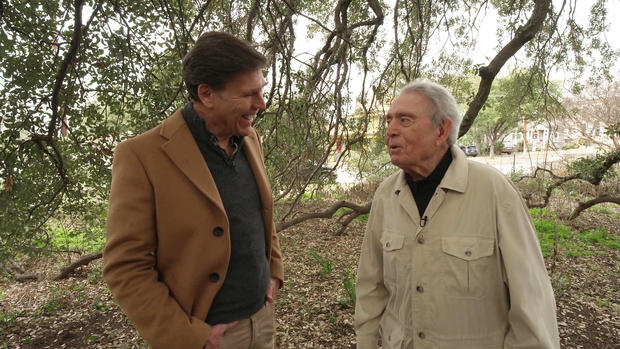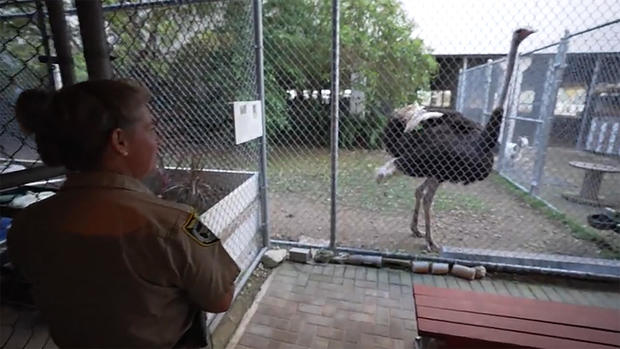CBS News
This week on “Sunday Morning” (April 28)

The Emmy Award-winning “CBS News Sunday Morning” is broadcast on CBS Sundays beginning at 9:00 a.m. ET. “Sunday Morning” also streams on the CBS News app beginning at 12:00 p.m. ET. (Download it here.)
Hosted by Jane Pauley
COVER STORY: Take it easy – The importance of being lazy
Social pressures to be productive – not to mention a culture that prizes multitasking – make doing nothing hard to do, for fear of being accused of the dreaded sin of laziness. However, experts say there are rewards for not pushing yourself to the edge all the time. Correspondent Susan Spencer looks at how some of the most productive and innovative people in history allowed themselves to take time out, just to be.
For more info:
- “Do Nothing: How to Break Away from Overworking, Overdoing, and Underliving” by Celeste Headlee (Harmony), in Trade Paperback, eBook and Audio formats, available via Amazon, Barnes & Noble and Bookshop.org
- Celeste Headlee (Official site)
- Lonnie Golden, Professor of Economics and Labor-Human Resources, Penn State Abington
- Earl K. Miller, Professor of Neuroscience, Picower Institute for Learning and Memory, Massachusetts Institute of Technology
- Institute for Advanced Study, Princeton, N.J.
ALMANAC: April 28
“Sunday Morning” looks back at historical events on this date.
HEADLINES: Campus unrest
David Pogue reports.
CBS News
ARTS: Stanley Whitney
Alina Cho reports.
For more info:
CBS News
MUSIC: Kate Hudson on her “Glorious” album
Kate Hudson made a name for herself as an Oscar-nominated actress in “Almost Famous.” But music has always been in her blood, and now Hudson is making a name for herself as a singer-songwriter. She talks with correspondent Tracy Smith about her debut album, “Glorious,” filled with her songs about life and love, and reveals the one song that truly rips her heart out.
PREVIEW: Kate Hudson says her relationship with her father, Bill Hudson, is “warming up” (with video)
For more info:
To watch Kate Hudson perform the single “Gonna Find Out,” from her new album, “Glorious,” click on the video player below:
PASSAGE: In memoriam
“Sunday Morning” remembers some of the notable figures who left us this week.
BOOKS: “The Demon of Unrest”: Recounting the first shots of the Civil War
Beginning on April 12, 1861, over the course of two days, more than 3,300 shells and cannon balls rained across Charleston Harbor towards Fort Sumter, the first shots fired in the Civil War. Correspondent Anthony Mason visits the fort with bestselling author Erik Larson, whose latest book, “The Demon of Unrest,” explores the events leading up to the bombardment and what Larson calls “the single most consequential day in American history.”
For more info:
- “The Demon of Unrest: A Saga of Hubris, Heartbreak, and Heroism at the Dawn of the Civil War” by Erik Larson (Crown), in Hardcover, Large Print, eBook and Audio formats, available April 30 via Amazon, Barnes & Noble and Bookshop.org
- eriklarsonbooks.com
- Fort Sumter and Fort Moultrie National Historical Park, Charleston, S.C.
- Fort Sumter Tours
- South Carolina Historical Society
- Drone footage by Sumner Crawford of Above All Media
- The Mills House Hotel, Charleston, D.C.
HARTMAN: TBD
CBS News
SUNDAY PROFILE: Dan Rather at 92: “You’re either gonna be involved or you’re gonna be totally irrelevant.”
It’s been almost 20 years since Dan Rather signed off as anchor and managing editor of the “CBS Evening News,” at the network where he spent 44 years covering wars, politics, and the assassination of JFK – and where he mentored a young correspondent named Lee Cowan. Rather, now 92, talks with Cowan about his illustrious career; about the story that gave him (and CBS) a black eye; and his post-CBS years, writing books and finding a new, younger audience on social media.
For more info:
CBS News
U.S.: A zoo for rescued animals, beneath a Key West jail
The Monroe County Sheriff’s Office Animal Farm, a small zoo on the grounds of a detention facility in Key West, was started by accident in the mid-1990s when word got out that the sheriff had rescued some ducks from a nearby road. Since then, many animals – abandoned, abused, confiscated or donated – have been brought to the farm, which is maintained by a small team of people incarcerated there. Correspondent Conor Knighton reports on a zoo that is making a difference in the lives of those incarcerated as well as the more than 100 animals currently residing there.
For more info:
Michael Reaves/Getty Images
SPORTS: The pageantry of the 150th Kentucky Derby
2024 marks the 150th running of the Kentucky Derby, the longest continuously-held sporting event in America. Correspondent Jim Axelrod visits Churchill Downs to explore the history and spectacle of the “Run for the Roses.”
FROM THE ARCHIVES: Ode to Secretariat (Video)
Charles Kuralt presents this remembrance of one of the truly great racehorses: Secretariat (1970-1989), whose monumental 31-length victory in the Belmont Stakes in 1973 was a run for the ages. We also hear from Penny Chenery Tweedy, Secretariat’s owner; Heywood Hale Broun, who covered Secretariat’s Triple Crown win; and Arthur Boyd Hancock III, the owner of Stone Farm, a 2,000 acre horse-breeding operation in Paris, Kentucky, who looks over the very last foal of Secretariat, Risen Starlet. Originally broadcast on “Sunday Morning” May 3, 1992.
For more info:
NATURE: Wildflowers in Missouri
WEB EXCLUSIVES:
THE BOOK REPORT: Reviews by Washington Post book critic Ron Charles
Recent picks from our book reviewer of new fiction and non-fiction titles.
For more info:
EXTENDED INTERVIEW: Jerry Seinfeld on comedy, directing, and Pop-Tarts (YouTube Video)
In this extended conversation with “Sunday Morning” correspondent Mo Rocca, comedian Jerry Seinfeld goes deep when talking about the precision of his approach to comedy, and how he made a fondly-remembered part of his youth – the breakfast staple Pop-Tarts – the subject of his directorial debut, the Netflix comedy “Unfrosted.”
The Emmy Award-winning “CBS News Sunday Morning” is broadcast on CBS Sundays beginning at 9:00 a.m. ET. Executive producer is Rand Morrison.
DVR Alert! Find out when “Sunday Morning” airs in your city
“Sunday Morning” also streams on the CBS News app beginning at 12:00 p.m. ET. (Download it here.)
Full episodes of “Sunday Morning” are now available to watch on demand on CBSNews.com, CBS.com and Paramount+, including via Apple TV, Android TV, Roku, Chromecast, Amazon FireTV/FireTV stick and Xbox.
Follow us on Twitter; Facebook; Instagram; YouTube; TikTok; and at cbssundaymorning.com.
You can also download the free “Sunday Morning” audio podcast at iTunes and at Play.it. Now you’ll never miss the trumpet!
CBS News
Breaking down FEMA boss’ testimony on hurricane response

Watch CBS News
Be the first to know
Get browser notifications for breaking news, live events, and exclusive reporting.
CBS News
Rep. Brad Wenstrup, hero of June 2017 shooting at House GOP baseball practice, recalls that day

As Rep. Brad Wenstrup prepares for his retirement in six weeks, he often recalls one day in particular. He was prone on the ground, face down in the grass, with a baseball helmet on his head.
The piercing sounds of screaming, gunfire and chaos surrounded him, persisting for several minutes. When it finally quieted, Wenstrup sprang to his feet and ran to his gravely injured colleague, GOP Rep. Steve Scalise of Louisiana, the House majority whip, a few hundred feet away.
With each stride that day in June 2017, Wenstrup said he was consumed by the memories of Iraq from 12 years earlier. And as Wenstrup, a decorated combat surgeon, made his run along the field to provide help to his colleague, Wenstrup pictured the patient he and his surgical team were not able to save 12 years earlier.
This time would be different, Wenstrup hoped.
He not only helped save the patient, but along with emergency responders, played a key role in heading off a political assassination.
Mark Wilson / Getty Images
Wenstrup, who was elected to Congress from suburban Cincinnati in 2012, helped treat Scalise, who had been shot by a gunman who opened fire at a House Republican baseball practice just before their 2017 annual congressional baseball game against Democrats.
“I saw the entry wound from the bullet, but I didn’t see an exit wound, so I knew he was in trouble,” Wenstrup said. “I had no doubt he was bleeding internally. I knew that if I couldn’t stop the bleeding, I at least needed to get him to drink fluids.” He began applying pressure to slow the bleeding and talking to Scalise to keep him alert and conscious.
Scalise had suffered a shot to his hip. His femur was shattered and his pelvis severely damaged.
Scalise recalled some of the immediate aftermath of the shooting and of Wenstrup’s care. He told CBS News, “He was putting pressure on the spot where the bullet went in. He then ultimately put a tourniquet on. And you know, later, my trauma surgeon told me that tourniquet saved my life.” Wenstrup had improvised a tourniquet with a belt and bandages to help slow the blood flow until Scalise was ushered away by emergency responders.
Tom Williams/CQ Roll Call
After he was airlifted to George Washington University hospital for emergency surgery, Scalise would spend several days unconscious. Grueling rehabilitation and reconstructive surgeries helped Scalise walk again.
With little fanfare last year, Wenstrup announced his retirement from Congress, which takes effect Jan. 3, 2025. Amid a wave of retirements of longtime members of Congress and a sea change in Washington after the 2024 elections, Wenstrup’s departure has been overlooked by some.
But not by Scalise or by many of Wenstrup’s House colleagues.
“He’s such a man of high integrity,” Scalise told CBS News. “He’s respected by his colleagues. He’s a chairman of a committee. He could have done even more things here in Congress, and his constituents would have elected him overwhelmingly. But he also knew it’s time.”
The man who opened fire on Scalise and his fellow Republicans was killed after an exchange of gunfire with a Capitol Police protective detail assigned to Scalise, who was given an additional protection as a member of House leadership. Gunman James Hodgkinson acted alone and was not connected to terrorism, federal investigators determined. He was carrying an SKS rifle and a 9 mm handgun when he opened fire.
Wenstrup is haunted by thoughts of the carnage that could have ensued if Scalise and the police unit had not been at the practice to protect the group.
“There were 136 rounds fired. I don’t think most people know that,” Wenstrup said. “If Steve Scalise wasn’t there and didn’t take a bullet for all of us, then there’s no (security) detail there.” Wenstrup said the gunman could have killed 20 to 30 members of Congress and staff.”
As he performed the initial emergency medical triage on Scalise, Wenstrup recalled eerily similar images from 12 years earlier, when he was deployed as a military doctor at Abu Ghraib in Iraq. He served in the U.S. Army Reserves in Iraq in the months before the troop surge. One day, a soldier was grievously wounded nearby and was rushed to Wenstrup’s post for surgery.
Wenstrup said the victim was a servicemember who had likely been hit by an improvised explosive device. “He was badly hit. There was no doubt about it, but he was still alive, and he was intubated and on the table,” Wenstrup recalled, sitting back in his chair and lowering the volume of his voice as he shared the account.
“It was a blunt injury. There severed arteries internally and his blood pressure started dropping,” Wenstrup said, “We opened him up, went in and there was blood everywhere. And we couldn’t stop. We couldn’t stop it.”
“We were just really distraught after that one,” Wenstrup said. “And that was going through my mind when I was with (Scalise) on that field.”
He urged arriving medics to rush an IV to Scalise, to ensure he stayed hydrated. The flashbacks to Iraq and 2005 continued. But this was different from that patient 12 years earlier, Wenstrup told himself. Scalise had not suffered the same blunt force trauma.
In a 2018 interview with CBS’ “60 Minutes,” Scalise recalled, “In a weird way, your body kind of goes numb. You know, as bad as the wounds were, and obviously I know now how severe it was. At the time, I guess my body had been shutting down a lot of the real pain. And I was just thinking about what was going on at the moment.”
The surgeons who saved Scalise at the hospital would credit Wenstrup with effective care at the shooting site, Scalise said.
Wenstrup’s efforts to help save Scalise also had an untold impact on America, averting a would-be assassination and any cascading impact it would have inflicted upon the nation.
Wenstrup said he and Scalise were casual acquaintances before the shooting. They later became friends — and roommates at a house in Washington, D.C., sharing a living quarters on days when Congress is in session.
“We are just very, very tight in our friendship,” Scalise told CBS News. “I’ve really gotten to know him and his wife. They’re just wonderful people.”
Wenstrup’s congressional career is ending amid uniquely toxic politics in the House. His departure comes as members of Congress complain of a loss of civility and cross-party relationships. Some of his Democratic colleagues told CBS News that Wenstrup’s departure will deprive the House of another of its more civil members.
“People will miss Brad up here, including me,” Rep. Greg Landsman, an Ohio Democrat told CBS News. “He leads with his heart and cares about making things happen for the people he serves. I love the guy.”
But Wenstrup has engaged in some heated political battles, including in the closing months of his career. In June, a House subcommittee chaired by Wenstrup, held a charged and animated hearing questioning Dr. Anthony Fauci, focusing on Fauci’s response to the COVID pandemic.
Wenstrup accused Fauci of running an office that was “unaccountable to the American people.” Wenstrup’s panel pursued Fauci’s personal emails and staged a two-day, 14-hour closed door deposition that Wenstrup characterized as “cordial” but pressing.
Democrats accused Wenstrup’s subcommittee of spreading misinformation about Fauci. The subcommittee’s ranking Democrat, Rep. Raul Ruiz of California, said in his opening statement, “After 15 months, the select subcommittee still does not possess a shred of evidence to substantiate these extreme allegations that Republicans have levied against Dr. Fauci for nearly four years.”
Sitting at a small table in the lobby of his office suite in the Rayburn House Office Building, Wenstrup recalled his blistering testimony during hearings into the formation of the House Jan. 6 select committee, which investigated the Capitol siege.
Wenstrup criticized Democratic leaders for not including a review of the baseball field shooting in the Jan. 6 committee’s work. “If the shooting killed 20 to 30 members of Congress, it would have changed the balance of power in the House of Representatives against the will of the people. That’s an insurrection. You’re throwing around that word? That’s an insurrection, I said. So, if you’re truly interested in protecting this beautiful Capitol and those who work in here, then we should make this part of this commission as well.”
Many of the other congressional Republicans who were on the field at the 2017 baseball practice shooting have long since departed, including those who were defeated in elections or retired. Gov. Ron DeSantis, who represented Florida, and former Sen. Jeff Flake of Arizona are among those who have left.
Wenstrup’s colleagues gave him a standing ovation on the House floor in September 2017, when Scalise returned to duties at the Capitol.
But Wenstrup’s retirement contributes to an unexpected dynamic. Among the officeholders from the shooting spree who are still in the House is the man who was hit. Scalise is expected to serve another term in 2025 as the House majority leader.
CBS News
Pentagon solves 1 UFO mystery but still probing cases of “large orange orb,” “large metallic cylinder”

The Pentagon office investigating UFOs, or what the government calls unidentified anomalous phenomena, resolved one of its most prominent cases — nicknamed “GOFAST” — its director told Congress in a hearing on Tuesday. (It’s the last one listed on the office’s website here).
All-domain Anomaly Resolution Office, Pentagon
The GOFAST video was made public in 2017 and shows what appears to be an object flying at a high speed just above water, but Dr. Jon Kosloski, the director of the All-Domain Anomaly Resolution Office, told Congress the object depicted is not actually too unusual.
“Through a very careful geospatial intelligence analysis and using trigonometry, we assess with high confidence that the object is not actually close to the water, but is rather closer to 13,000 feet,” Kosloski said.
Kosloski did not identify the object, but he said that a “trick of the eye” called parallax made the object appear anomalous — or out of the ordinary — when it was not. He said a detailed report on parallax will be available on the All-Domain Anomaly Resolution Office website.
The “GOFAST” video was recorded by a fighter jet from the USS Theodore Roosevelt off the East coast of the U.S. and made public in 2017.
After providing examples to Congress of two other resolved cases the Defense Department calls “The Puerto Rico Objects” and “Mt. Etna,” Kosloski described cases his office is still actively investigating, notably, an “orange orb” and “a metallic cylinder.”
These cases are likely part of the 21 cases that the recently released annual unidentified aerial phenomena report said contain enough information and data for the office to actively investigate.
One case was reported by a law enforcement officer “out West” who observed “a large orange orb floating several hundred feet above the ground,” according to Kosloski.
As the officer approached where he thought the orb would be, he saw “a blacker than black object” that was about the size of a Prius. When he reached a distance of 40-60 meters away from the object, it tilted 45 degrees and shot up vertically, traveling faster than any drone he had seen before.
Just as it left his field of view, it emitted bright red and blue lights that lit up the inside of his vehicle “as brightly as if someone had set off fireworks just outside of his vehicle,” Kosloski told Congress.
Another case was reported from the southeastern part of the United States after two cars driven by government contractors left a facility around 9 a.m. and saw “a large metallic cylinder about the size of a commercial airplane.”
After they observed it for 15-20 seconds, it disappeared.
“Obviously an object that large and stationary — unless it’s a blimp — is unusual but then disappearing, we can’t explain how that would happen,” Kosloski said.












